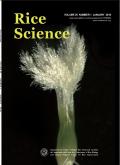解淀粉芽孢杆菌与短芽孢杆菌混合调控水稻根际土壤群落结构抑制水稻幼苗枯萎病
IF 5.6
2区 农林科学
Q1 AGRONOMY
引用次数: 0
摘要
水稻幼苗枯萎病是由包括尖孢镰刀菌在内的多种真菌引起的,对水稻生产构成严重威胁。随着人们对使用杀菌剂管理水稻幼苗枯萎病所带来的环境和安全危害的认识不断提高,人们已将重点转向生物防治剂。本研究从水田中分离出对尖孢镰刀菌生长有显著抑制作用的生防菌,鉴定菌株为解淀粉芽孢杆菌T40和短小芽孢杆菌T208。此外,我们的研究结果表明,这些芽孢杆菌菌株在土壤中联合施用比单独使用更有效地降低水稻幼苗枯萎病的发病率。16S和内部转录间隔rna基因测序结果表明,T40和T208混合菌株的平均聚类系数最低,与接种尖孢镰刀菌的水稻幼苗生物量呈负相关。此外,这种混合导致更高的随机组合(平均|βNTI| <;2)与单株施用相比,降低了水稻根际细菌的选择压力。T40和T208混合菌株也显著增加了防御相关基因的表达。综上所述,菌株T40和菌株T208混配能有效调节微生物群落结构,增强微生物网络稳定性,增强水稻幼苗枯萎病抗性。本研究为作物保护生物资源的开发利用提供了依据。本文章由计算机程序翻译,如有差异,请以英文原文为准。
Mixture of Bacillus Amyloliquefaciens and Bacillus Pumilus Modulates Community Structures of Rice Rhizosphere Soil to Suppress Rice Seedling Blight
Rice seedling blight, caused by various fungi, including Fusarium oxysporum, poses a severe threat to rice production. As awareness grows regarding the environmental and safety hazards associated with the application of fungicides for managing rice seedling blight, there has been a shift in focus towards biological control agents. In this study, we isolated biocontrol bacteria from paddy fields that significantly inhibited the growth of F. oxysporum in vitro and identified the strains as Bacillus amyloliquefaciens T40 and Bacillus pumilus T208. Additionally, our findings indicated that the combined application of these Bacillus strains in soil was more effective in reducing the incidence of rice seedling blight than their individual use. Analysis of 16S and internal transcribed spacer rRNA gene sequencing data revealed that the mixture of the T40 and T208 strains exhibited the lowest average clustering coefficients, which were negatively correlated with the biomass of F. oxysporum-inoculated rice seedlings. Furthermore, this mixture led to higher stochastic assembly (average |βNTI| < 2) and reduced selection pressures on rice rhizosphere bacteria compared with individual strain applications. The mixture of the T40 and T208 strains also significantly increased the expression of defense-related genes. In conclusion, the mixture of the T40 and T208 strains effectively modulates microbial community structures, enhances microbial network stability, and boosts the resistance against rice seedling blight. Our study supports the development and utilization of biological resources for crop protection.
求助全文
通过发布文献求助,成功后即可免费获取论文全文。
去求助
来源期刊

Rice Science
Agricultural and Biological Sciences-Agronomy and Crop Science
CiteScore
8.90
自引率
6.20%
发文量
55
审稿时长
40 weeks
期刊介绍:
Rice Science is an international research journal sponsored by China National Rice Research Institute. It publishes original research papers, review articles, as well as short communications on all aspects of rice sciences in English language. Some of the topics that may be included in each issue are: breeding and genetics, biotechnology, germplasm resources, crop management, pest management, physiology, soil and fertilizer management, ecology, cereal chemistry and post-harvest processing.
 求助内容:
求助内容: 应助结果提醒方式:
应助结果提醒方式:


